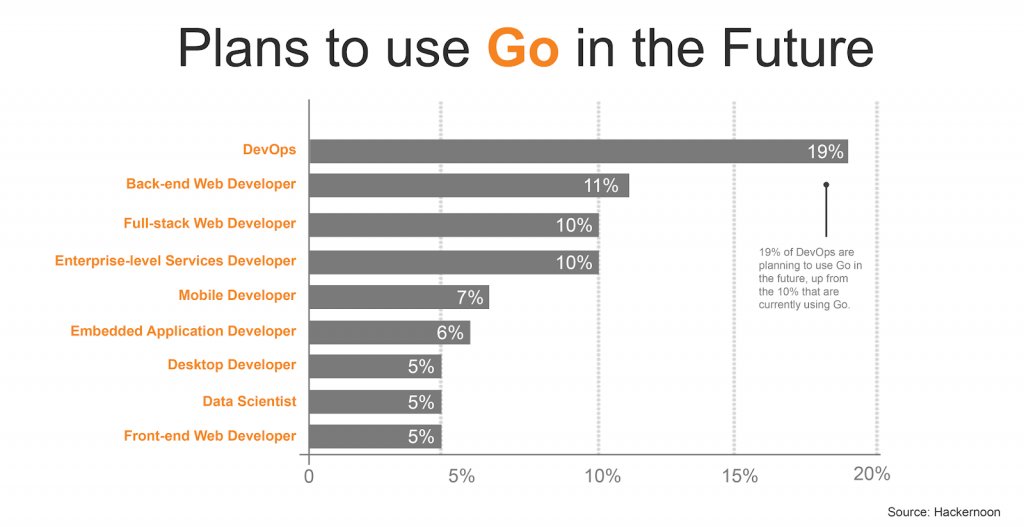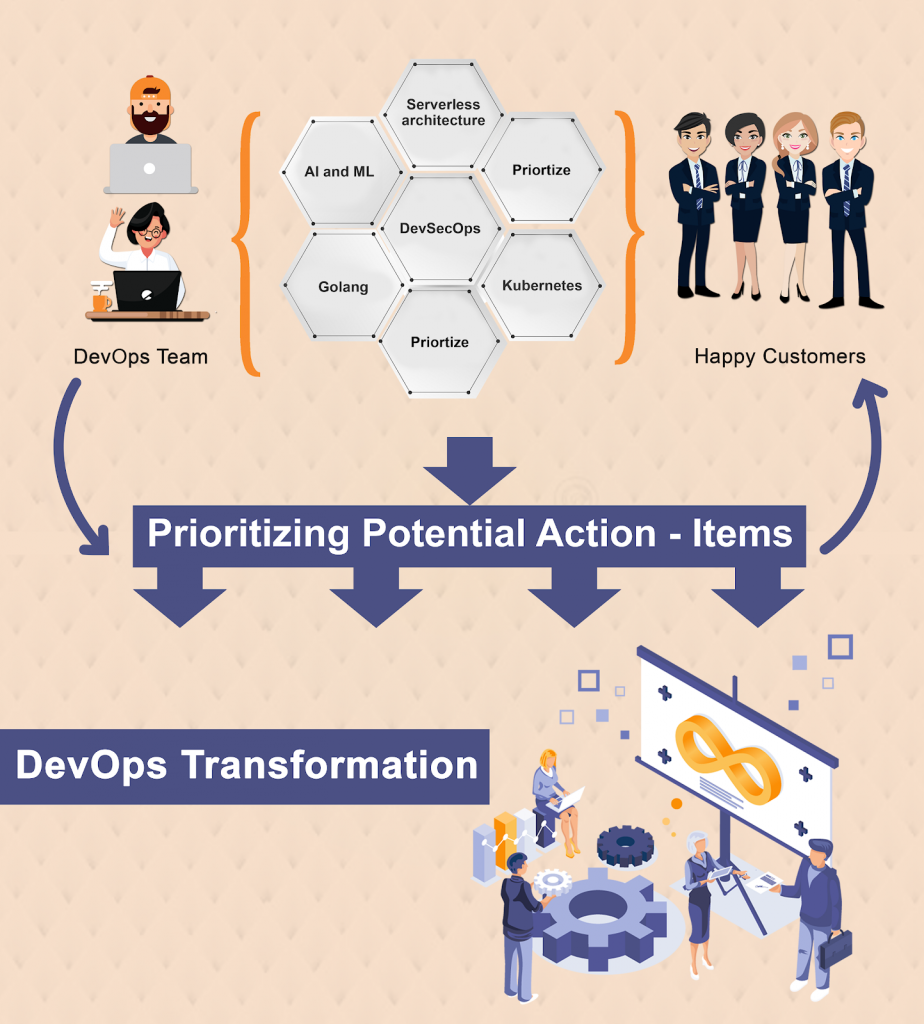Blog
What is the Recommended way to Prioritize the Potential Action-Items for the DevOps Transformation?
Your journey should begin with analyzing the current state of various operating teams working under the DevOps circle. As a first step, list the road-blocks that troubled you in the last year, the number of attempts and solutions you tried to fix the problems, and your approach to minimize the issues involved in the operating teams. After analyzing and comprehending your prerequisites, the second step of DevOps transformation achieved smoothly, which helps to formulate the detailed structure of potential action items.
Prioritizing the potential action-items for the DevOps transformation
2020 DevOps practices are now one month old, and its top three areas such as scripting, process re-engineering, communicating, and collaborating with others are the areas you need to monitor in order to prioritize the potential action-items for the DevOps transformation.
Embrace serverless architecture migration.
Serverless architecture, which is also known as FaaS (Function as a Service), brings machine dependency closer to the enterprise workflow. In this environment, cloud providers will be responsible for the allocation and provisioning of servers by performing back-end services. This move can help enterprises to reduce administrative costs, which are correlated with server maintenance. The rate of migrating on-prem servers to the cloud will only increase this year and ahead.
If you’re keen on embracing serverless architecture migration, then you should have an answer to the below questions.
What is the size of your applications? Is the count of smaller applications more than mid-level applications? Is your workflow heavily dependent on large-scale applications with a significant business outcome? How much you’re planning to invest (budget, time/duration, resource, teams) in managing and provisioning servers?
Note: For small-sized applications, serverless architecture migration is less impacting over large-scale ones.
If you own dedicated servers for your workflow, did you face any problems with server management and in the configuring process? If yes, then how often?
Note: Bigger sized applications are complicated to handle on servers if encountered with errors, serverless architecture minimizes such consequences.
Successful serverless architecture migration needs a full-fledged analysis of your existing server management practices. If the analyzed result shows you’re spending more on maintenance than what you’re intended to, then you should consider migrating to the serverless architecture.
Adapt Kubernetes to get most out of containerization
Though many of us know Kubernetes is one of the well-known open-source container orchestration tools to automate application deployment, many fail to use it in the right way to suffice their need or reluctant implement it due to lack of technical support.
Businesses that have a large number of containers in place for large-scale applications or workloads, Kubernetes can be a wish-come-true option to deploy, manage, connect, and update the containers with ease. This tool is handy to create a staging environment and move applications into production in a smooth way with less possibility of complications. The workflow without management tools for containers will be overwhelmed by a series of orchestration tasks to keep up the work progress, whereas, few businesses manage their containers manually, which is time taking and waste of resources just for container management. If you’re keen to implement Kubernetes for container management, then consider:
- Does your application consist of microserver architecture?
- Determine whether you’re already using microservice architecture or planning to migrate to one?
- If your workflow doesn’t have any containers, then you don’t need to use Kubernetes
- Is your team experience difficult to orchestrate containers, but not in creating and using containers?
Looking at the current scenario of DevOps practices and transformation, Kubernetes is here to stay at least for the next few years. So, you need to assess existing container management set up and see how Kubernetes can be a potential action-item in your DevOps journey.
It’s a sensible decision to invest in Golang to go big in the future.
Golang, in short, known as Go, which is an open-source programming language developed by Google for DevOps tools like Kubernetes, Docker, EtcD, among others. Though it came to light in recent years, it brings wide flexibility to sync well with DevOps practices by keeping scalability, application performance efficiency, portability, and many other elements in a set format for flawless experience in the journey. Big names in the industry like YouTube, Uber, Apple, and Twitter are already using Go as one of the measure parts in their workflow. The recent stats say that Golang is one of the top 15 growing computer languages in the United States. Since Go is slowly picking pace in user count, your investment can bring fruitful results later in the game. So, it can be one of the potential action-items to extract more out of DevOps to drive more business benefits.

Rely on AI and ML to fill skills gaps
Every DevOps pipeline that consists of Continuous Integration, Continuous Delivery, and Continuous Deployment and Testing needs an advanced technology awareness to match the pace of growing automation influence in the workflow. It can be achieved by AI and ML practices, which are expected to be an integral part of test creation, execution, and automation. This move can improve the data and analytics part in DevOps and open the doors for comprehensive data science and deep learning to enhance the team skill set. Whether you’re a first-timer in DevOps transformation or second, making space for AI and ML could bring you a bunch of benefits in the long run.
Security is the biggest concern; DevSecOps can be the solution
The year 2019 was convincing for cloud adoption, security, and DevOps. Many big and small businesses embraced cloud-based infrastructures, serverless architecture, and DevOps practices to speed up the development and release cycles. This, in turn, increased the need for security upgrades to minimize the vulnerabilities which may appear during the development and testing process. Thus, the year 2020 may experience a huge demand for integrating DevSecOps in the workflow to minimize such consequences.
At the baseline of the development and testing process, the coordination between respective team members like operation and security ensures the right balance interacting with the development team. DevSecOps can do this job with ease, which also helps to drive potential restraints and efforts to strengthen the team ability to:
- Maximize the delivery speed of the project
- Manage the outages and compliance of the workflow
- Minimize work-in-progress (WIP) scenarios
Enterprises having DevOps pipeline should look forward to uniting development, IT operations, QA testing, and security teams under one common rubric to ensure the security. And DevSecOps is a perfect fit to achieve this stint.
Summing Up
As DevOps transformation is grooming the modern IT workflow, advanced approaches are shaping in the form of new tools and practices. The definition of DevOps changes as a panorama of the IT industry changes its direction with new challenges and solutions, but in the world of continuous integration and rapid release cycles, you just can’t wait for your turn to adopt new practices and to prioritize potential action-items for your DevOps journey. Advanced DevOps practice is just another theme, and we Evolutyz give new color options to match your requirement with the solution and services that blend well with your workflow. Contact us to know how we can add value to your business.

